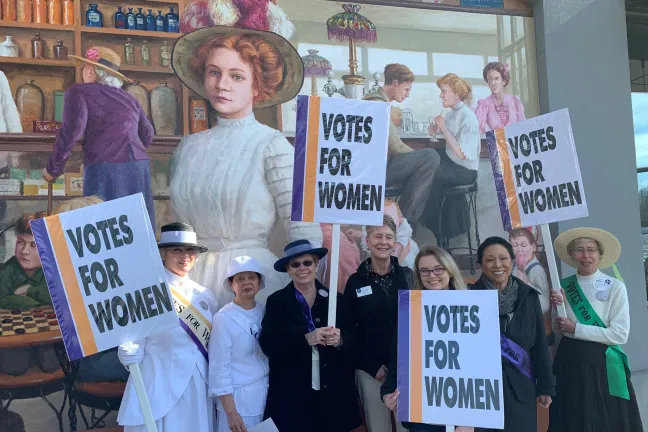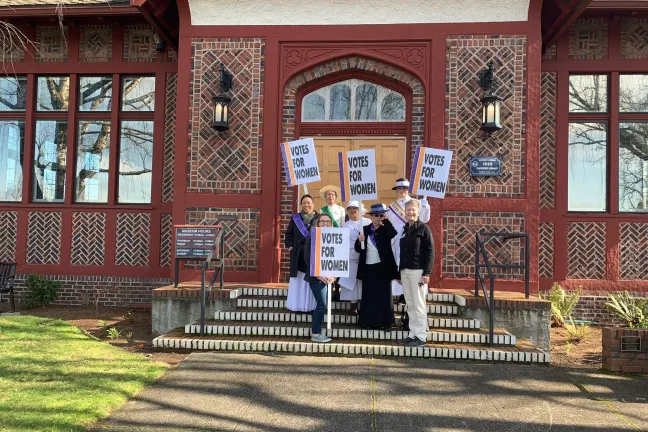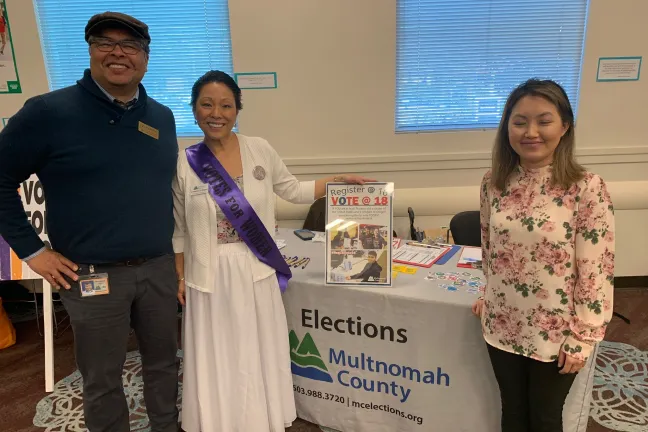On Feb. 22, Commissioner Lori Stegmann joined the American Association of University Women in celebrating the 100th anniversary of Womens’ Right to Vote. These are her prepared remarks:
The passage of the 19th Amendment was a moment in time that took decades to achieve. Much like the political climate we live in today, there was critical momentum that was achieved by a series of key actions and decisions that led to the passage of the actual constitutional amendment. Several western states had already acknowledged the right of women to vote and with the approval of suffrage in New York in 1917, the pressure built. However, it still took years for women of color to be recognized and included in suffrage. And even with the right to vote it took decades for large numbers of women to begin to change the tides of politics, social action, and democracy. But over the last 100 years, that slow sea of change has opened the floodgates for wider political inclusion. And today, we see this on the ballot through better representation of our communities with more women and people of color running for and holding office than ever before.
What the Nineteenth Amendment and the women’s suffrage movement means on 100th anniversary of the right to vote
I have the privilege of serving on an all\-women Board of Multnomah County Commissioners. And what is even more remarkable is that the majority of us are women of color. The passage of the 19th Amendment was the first constitutional step in a long journey that paved the way for so many women that came before me and will come after me, to not only vote but to hold political office. Being able to cast a ballot and have a voice in our elections is the basis of our democracy. And because of that right I am able to serve my community as a mother, a woman of color, and an immigrant, and bring my voice and perspective to the rooms that we have historically been excluded from.
Historic women leaders who stand out
So I want to share the story of a couple of my heroines in the suffrage movement. Harriet “Hattie” Redmond is one of Oregon’s own suffragettes. Her parents, Reuben and LaVinia “Vina” Crawford, were emancipated slaves who passed on their thirst for freedom and their right to full citizenship in their daughter. Hattie helped bring those dreams to light through her civic activism. The right to vote was especially important to her as a black woman living in a state that had codified black exclusion laws in its own constitution. Redmond’s work for voting rights helped lay the groundwork for the Black Civil Rights movement of the mid-twentieth century.
Another suffragist of color was Mabel Lee who was born in Guangzhou (Canton), near Hong Kong China in 1896. By the time she was 16, Mabel Lee was a well known figure in New York’s suffrage movement. And during a suffragist parade in 1912 to advocate for women’s voting rights, Lee led the parade on horseback.
She started her studies at Barnard College in New York City in 1912. Barnard College, an all-women’s school, was founded because Columbia University refused to admit women. During her time in college she wrote multiple feminist essays advocating for women's right to vote.
In 1917, women finally won the right to vote in New York State. And then three years later, in 1920, the 19th Amendment gave women throughout the country the right to vote. But not all women in the U.S. were allowed to vote. Chinese women, like Mabel Lee, could not vote until 1943. This was because of the Chinese Exclusion Act, a Federal law in place from 1882 to 1943. This Act limited Chinese immigration and prevented Chinese immigrants from becoming citizens. Without citizenship, Mabel Lee could not vote. Yet, she and other Chinese suffragists advocated for women’s voting rights, even though they did not benefit from this legislation.
Sadly, Mabel Lee died in 1966 and we don’t know if she ever became a U.S. citizen or if se ever voted in the US.
This is such a powerful story for me. I was incredibly blessed to be adopted by an American family as an infant. And at the age of 4, I was able to become a U.S. naturalized citizen. And because of that, I am able to vote and hold certain offices. However, I can never become president or vice president because I was not born here. And yet I believe that immigrants are some of the most patriotic and loyal citizens in our country because many of us come from war torn countries where we know what it is like to live under oppression. But at least I am in good company with the likes of Secretaries of State Henry Kissinger and Madeleine Albright!
Why it is important to continue teaching and learning about women’s suffrage
As we know there are many false narratives that have permeated our society, and the history of the 19th Amendment is no exception. And while I am incredibly grateful that women have the right to vote, it wasn’t just about gender. It was also about race. The 19th Amendment was closely tied to the 15th Amendment (passed in 1870), which decreed that a citizen’s right to vote could not be “denied or abridged by the United States or any State on account of race, color, or previous condition of servitude.” And senators of that time argued that if the 19th Amendment passed it would give black women and men the right to vote in the South
Even after the passage of the 19th Amendment, some women behind the suffrage movement feared they would alienate southern lawmakers so they shut out black women from the movement. They were involved in blatant racism and those residual undertones can still be found in our politics and social policies today.
This past week our Board of County Commissioners proclaimed February as Black History and Future Month. So when we celebrate and reflect on women’s right to vote, we must remember that this singular issue was deeply entwined with racist policies around exclusion and immigration. And that while we celebrate this 100th year milestone, we still have a long way to go before the rights of women and marginalized community members are truly achieved. And that everyday those rights must be fought for and protected.
Other areas that need to be addressed or changed to continue the push for gender equality
As a proud member of AAUW, (the American Association of University Women), I am well aware of the disparities that still exist today. I will continue to fight to improve outcomes for women and communities of color and increase family friendly policies in the workplace. Our workplaces are built around a traditional, male-centered, design that values capitalism and fails to recognize the importance of a healthy work-life balance.
AAUW’s website lists some startling facts around income disparities for women and I’d like to share five of those with you:
1. Women working full-time earn roughly 80 percent of men’s salaries.
2. Mothers, including those who never left the workforce, get paid less than other women. While men don’t experience any loss in earnings when they become dads.
3. The pay gap widens as women get older. Women 55 to 64 are paid 78 percent as much as men of the same age, a gap of more than double that women ages 20-24.
4. Latinas have the widest pay gap.
Latinas earn just 53 percent of what white men make in a year—followed by black women, whose annual salaries are 61 percent of those of white men.
This means it takes Latinas almost an entire extra year of full-time, year-round work to be paid what the average white man took home by December 31. Latinas are both overrepresented in low-paying occupations and underrepresented at the top. Moreover, Latinas are paid less than white and Asian women, even when they have the same educational credentials.
5. Women are less likely to negotiate than men and less confident when doing so.
According to a recent poll, 51 percent of Americans have negotiated for higher pay, with men negotiating slightly more than women (54 percent compared to 47 percent). And men are more confident in negotiating for salaries (61 percent) compared to women at (53 percent).
Negotiating can be tricky for women, but it’s an important way to help close the pay gap. Research suggests that some of the behaviors that help men, like self-promotion and assertiveness, can backfire for women. Still, there are effective tactics women can use to ask for higher salaries and better benefits, including knowing what their skills are worth, making clear what they bring to the table, emphasizing common goals, and maintaining a positive attitude. I encourage you to take a look at AAUW’s free online Work Smart course that trains women in these strategies.
So in closing, I want to thank AAUW for inviting me to share my perspective on the importance and significance of this 100th anniversary of our right to vote. And let me say that serving on the Multnomah County board has been one of the greatest honors of my life. It has allowed me to grow and to be seen in places where I know I can make a meaningful contribution. And at the end of the day isn’t that what we all want - to be seen and recognized for who really are.
Thank you.



